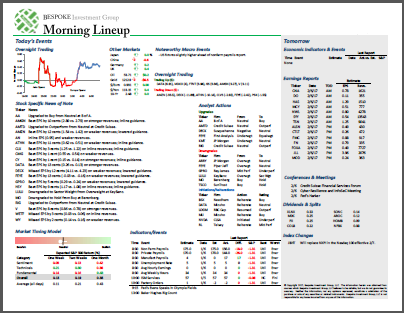See what’s driving market performance around the world in today’s Morning Lineup. Bespoke’s Morning Lineup is the best way to start your trading day. Read it now by starting a two-week trial to Bespoke Premium. CLICK HERE to learn more and start your trial.
“No company can afford not to move forward. It may be at the top of the heap today but at the bottom of the heap tomorrow, if it doesn’t.” – James Cash Penney
Below is a snippet of content from today’s Morning Lineup for Bespoke Premium members. Start a two-week trial to Bespoke Premium now to access the full report.
Futures were already modestly weaker heading into the January Retail Sales report, but the much stronger-than-expected readings have added extra pressure to equity prices as Treasury yields continue to rise. The 10-year yield is on pace to close at its highest level of the year while the 2-year yield is knocking on its cycle highs from late October. Empire Manufacturing for the month of February was still negative but came in better than expected after showing a larger-than-expected improvement from January’s dismal readings. Still on the agenda today, we have Industrial Production, Capacity Utilization, Business Inventories, and Homebuilder sentiment. Lower rates had been helping the housing sector earlier this year, but increases in yields over the last week or so haven’t been helpful.
With Retail Sales on the front burner this morning, we wanted to provide a quick update on the performance of retail-related stocks so far this year. The two most popular ETFs tracking the retail sector are the VanEck Retail ETF (RTH) and the S&P Retail ETF (XRT). Depending on which one you look at, YTD performance varies greatly. RTH has rallied 5.45% since the start of the year, while XRT has nearly tripled that performance with a gain of 16.33%.
So, what explains the outperformance this year? Looking at the top ten holding of each ETF and their YTD performance, they may be retail-related ETFs, but they sure don’t have a lot in common. XRT is basically a broad-based equal-weighted ETF where no company has a weighting in excess of 2.5%. RTH, however, is a more top-heavy market cap-weighted tracker of the retail space. In RTH, Amazon.com (AMZN) accounts for over 20% of the holdings, Home Depot (HD) accounts for 8%, and Walmart (WMT) and Costco (COST) each have a weighting of about 6%.
As shown in the chart below, not one of the top ten holdings of XRT is also a top-ten holding of RTH, and all of the top ten holdings of XRT are up sharply YTD. In fact, the worst-performing top ten holding of XRT (Children’s Place) is still up over 25% YTD which is more than five percentage points better than the top performing top ten holding of RTH (AMZN).

The performance disparity between the two ETFs hasn’t just been confined to this year. Looking at the relative strength of the two ETFs over the last three years shows how they have traded off between periods when each one took the lead. From the early days of COVID through early 2021, XRT outperformed RTH by a wide margin, but during the bear market of 2022, it was RTH that outperformed as the largest cap retailers went down less than many of the smaller ones. This year, though, the tide has been turning in the first six weeks of the year. Despite tracking the same sector of the economy, the performance of both XRT and RTH over the last three years shows how even if you get the macro trend right, how you implement the trade will be just as, if not even more important than the premise behind the trade in the first place.

Our Morning Lineup keeps readers on top of earnings data, economic news, global headlines, and market internals. We’re biased (of course!), but we think it’s the best and most helpful pre-market report in existence!
Start a two-week trial to Bespoke Premium to read today’s full Morning Lineup.

